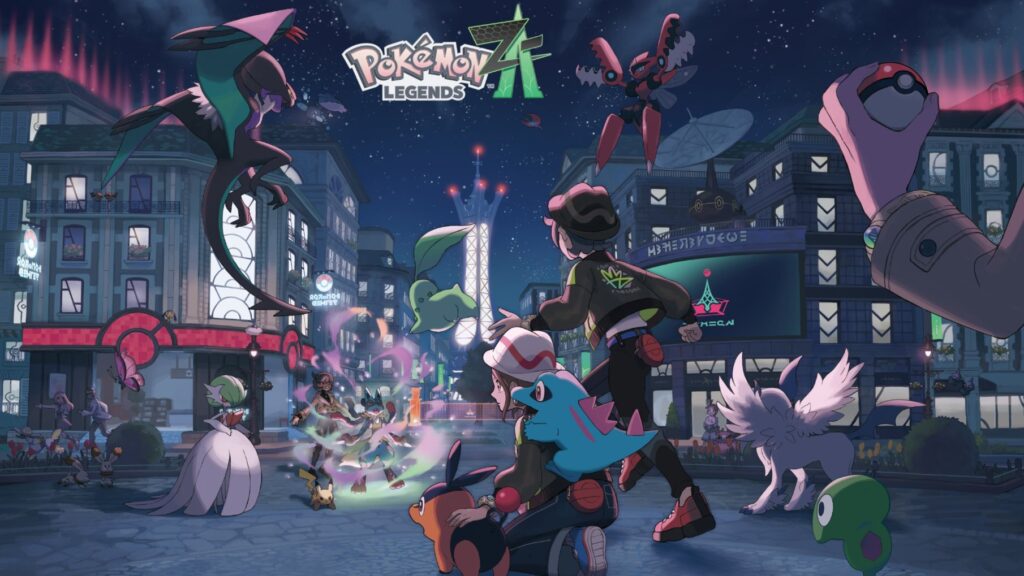Twelve years after the release of Pokémon X and Pokémon Y, we’re finally returning to the Kalos region with *Pokémon Legends: Z-A*. The newest entry in the mainline series and the second “Legends” title, PLZA reinvents the core battling system of Pokémon and introduces a vibrant cast of new characters. It’s a refreshingly fun adventure that’s strongly enhanced by the power of the Nintendo Switch 2.
### City of Lights
*Pokémon Legends: Z-A* is set entirely in Lumiose City, Pokémon’s Paris analogue. It’s here that players join Team MZ, a small group of Pokémon Trainers looking to maintain peace in Lumiose City. Together, you battle villainous foes and embark on a mission to solve the mystery of Rogue Mega Evolution, a phenomenon affecting the wild Pokémon that call Lumiose home.
The core cast of PLZA quickly became one of my favorite Pokémon ensembles in recent memory. They each have vastly different ambitions and backgrounds that led them to join Team MZ, and although they spend a significant amount of time bickering, there’s a genuine family feel to this small crew. Nearly every Main Mission involves at least one of Urbain/Taunie, Naveen, and Lida, and the game does an excellent job fleshing out their characters.
This sentiment extends beyond Team MZ. Both visually and narratively, PLZA is packed with unique and interesting characters that jump off the screen. It’s this group of colorful NPCs that makes the story of PLZA so engaging.
As the strange phenomenon of Mega Evolution worsens, you slowly unravel the mysteries of Lumiose City and its history. *Pokémon Legends: Z-A* is, in many ways, a pseudo-sequel to *Pokémon X* and *Pokémon Y*. Fans of those 3DS games have an absolute buffet of references and narrative tie-ins to explore. I had a big grin on my face during many of PLZA’s reveals and climactic moments.
It was understandable to be concerned when Game Freak announced that *Pokémon Legends: Z-A* would be set entirely in one city, especially given the expansive map featured in *Pokémon Scarlet* and *Pokémon Violet*. However, players should rest assured knowing this is a fully realized Lumiose City. The small circular town from Gen 6 that you could explore in less than 20 minutes is now a sprawling metropolis filled with new structures and areas to discover. Even after surpassing 30 hours of playtime, I was still finding new things and thinking, “Huh, I didn’t know that was over there.”
### Mega Evolving the Formula
The introduction of Mega Evolution in *X* and *Y* kicked off a tradition of adding new gimmicks to every new generation of Pokémon games, but nothing quite matched the spectacle and competitive twist that Mega Evolution brought. Thankfully, Mega Evolution is back in a massive way in *Pokémon Legends: Z-A*.
As players progress through the story, they’ll find a plethora of new Mega Evolved forms for Pokémon that previously didn’t have them — like Dragonite and Hawlucha. It felt great to be collecting Mega Stones again, and I was wowed by several of the new forms.
Mega Evolution is, of course, a battling mechanic, which brings me to the most significant change between *Pokémon Legends: Z-A* and all that came before it: real-time battles. The turn-based format is gone, replaced by an action system demanding quick reactions and a high volume of inputs.
Similar to some other Pokémon games of the Switch era, your trainer can walk around the field during a battle. Now, your Pokémon will follow you. With the new action system, you dodge attacks by physically moving out of the way before they hit. When dishing out moves, you must consider field placement and the time it takes for the move animation to finish.
PP, which previously limited how many times a Pokémon could use a certain move, has been replaced by a cooldown timer—stronger moves take longer to become usable again.
The real-time battle system in *Pokémon Legends: Z-A* is simply awesome. It feels like the series has finally delivered on the fantasy of experiencing battles that play out like in the Pokémon anime. It also recontextualizes nearly every move in the game. For example, moves like Protect and Detect now require precise timing to counter incoming attacks, allowing for satisfying counterplays.
Moves like Bullet Seed and Flamethrower can be dodged by leading your Pokémon away from the projectiles. Do so fast enough, and your opponent will be wide open for a counterattack. There’s a fluidity that makes every battle feel cinematic.
There will undoubtedly be players who yearn for the classic system, but if you get on board with the new format, there’s a lot of fun to be had.
### Wild Pokémon and Exploration
The real-time system also applies to encounters with wild Pokémon. When you spot a creature, you can throw a Pokéball to capture it. If you fail, the Pokémon may attack or flee, depending on its disposition. This can escalate to situations where multiple Pokémon attack you at once. In one area, I was overwhelmed by a group of Pyroar and had to use the wide-reaching move Surf to dispatch multiple creatures simultaneously.
The majority of Pokémon are found in Wild Zones, but not all of them. You’ll also spot Pokémon in trees, alleyways, lakes, and other manmade bodies of water. Some Pokémon are exclusive to the rooftops of Lumiose or only appear at night.
Alpha Pokémon have returned, and these oversized creatures remain as intimidating as ever. Running away from one trying to kill you never gets old.
### Night Life and the Z-A Royale
Most battling happens at night during the Z-A Royale, a city-wide tournament where top trainers fight to earn Points redeemable for Challenger Tickets. These tickets allow participation in Promotion Matches as you climb from rank Z to A.
While in a designated tournament area known as a Battle Zone, the classic Pokémon battle philosophy applies: battle is on sight. If another trainer spots you first, you’re forced into battle with a brief delay before you can act, leaving your Pokémon open to attacks. This encourages stealth and preemptive strikes so you can get the upper hand.
Points are earned by winning battles but can be multiplied by collecting Bonus Cards. These add extra challenges—like eliminating Pokémon with certain move types, starting battles undetected, or inflicting specific status conditions—and yield large rewards if completed.
Your performance in the Z-A Royale is directly tied to story progression; promotion matches unlock after Main Missions. This does reduce the competitive edge somewhat, and there is one aspect of this feature I disliked for spoiler reasons. Still, it’s cool to meet various characters you battle during Promotion Matches, and I liked that they were all real NPCs you could find around the city.
I never once grew tired of battling in *Pokémon Legends: Z-A*. Making battles a designated nighttime activity helped prevent fatigue, which often sets in after long sessions in traditional Pokémon games.
One disappointment is that there are no Abilities in PLZA, which traditionally add important dynamics to battles and team-building.
Trainers continue to spawn within a Battle Zone until day breaks. You’re free to do other activities during the night as well. The day and night cycles are timed, but you can rest on benches to fast-forward through them. However, you must watch the full sunset and daybreak animations every time they trigger, which can get tedious despite their short length.
### A Generational Leap
I played the Switch 2 Edition of *Pokémon Legends: Z-A* for this review, and it was a breath of fresh air after a generation of Pokémon games that suffered from performance issues on the base Switch.
PLZA runs at a high framerate in both TV and handheld modes. I noticed virtually no stuttering or slowdown throughout my entire playthrough — a stark contrast to *Scarlet/Violet* and *Pokémon Legends: Arceus*, which had performance issues that detracted from the experience.
Even if you’re not into specs, you’ll appreciate the improved performance on Switch 2. It adds immersion when everything runs buttery smooth without constant hitches or textures popping in and out. Fast traveling and exiting buildings load so quickly, I couldn’t finish reading the loading screen tips.
That said, I wouldn’t call *Pokémon Legends: Z-A* a visual showcase. The game runs well, but it still has the rough aesthetic synonymous with recent 3D Pokémon titles. There’s aliasing that makes edges look rigid and unfinished, and human characters cycle through a small set of stiff animations. This gives the game a somewhat low-budget feel (by AAA standards), which is a shame given how lucrative this franchise is.
### From Lumiose, With Love
*Pokémon Legends: Z-A* gave me just about everything I wanted from a new Legends game. It continues the trend of bucking series norms while maintaining what makes these games special for fans.
I fell in love with the characters and am excited to continue the adventure with upcoming DLC. The new battle system feels like a watershed moment for the franchise, and I hope to see it again soon.
As a fan who always lamented never getting a “Pokémon Z” after *X* and *Y*, this return to Lumiose City is what I’ve been waiting over a decade for.
—
*This review is based on a Switch 2 code provided by the publisher. Pokémon Legends: Z-A launches on October 16, 2025, for Nintendo Switch and Nintendo Switch 2.*
https://www.shacknews.com/article/146331/pokemon-legends-za-review-score

